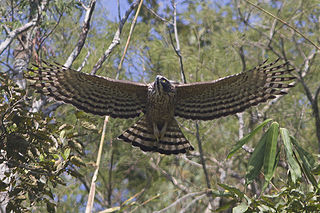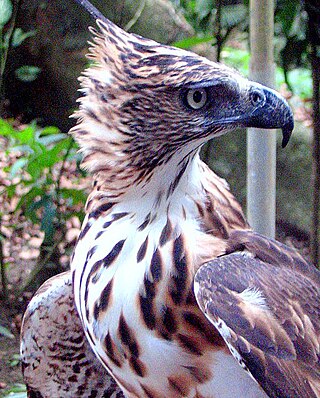
Eagle is the common name for many large birds of prey of the family Accipitridae. Eagles belong to several groups of genera, some of which are closely related. True eagles comprise the genus Aquila. Most of the 68 species of eagles are from Eurasia and Africa. Outside this area, just 14 species can be found—2 in North America, 9 in Central and South America, and 3 in Australia.

Wallacea is a biogeographical designation for a group of mainly Indonesian islands separated by deep-water straits from the Asian and Australian continental shelves. Wallacea includes Sulawesi, the largest island in the group, as well as Lombok, Sumbawa, Flores, Sumba, Timor, Halmahera, Buru, Seram, and many smaller islands. The islands of Wallacea lie between the Sunda Shelf to the west, and the Sahul Shelf including Australia and New Guinea to the south and east. The total land area of Wallacea is 347,000 km2 (134,000 sq mi).

The changeable hawk-eagle(Nisaetus cirrhatus) or crested hawk-eagle is a large bird of prey species of the family Accipitridae. More informal or antiquated English common names include the marsh hawk-eagle or Indian crested hawk-eagle. It is a member of the subfamily Aquilinae, with signature feathers, absent in tropical raptors from outside this subfamily, covering the tarsus. It was formerly placed in the genus Spizaetus, but studies pointed to the group being paraphyletic resulting in the Old World members being placed in Nisaetus and separated from the New World species. It is a typical “hawk-eagle” in that it is an agile forest-dwelling predator and like many such eagles readily varies its prey selection between birds, mammals or reptiles as well as other vertebrates. Among the members of its genus, the changeable hawk-eagle stands out as the most widely distributed, adaptable and abundant species. Individuals show a wide range of variation in plumage from pale to dark, varying with moult and age giving rise to the name "changeable".

The mountain hawk-eagle or Hodgson's hawk-eagle, is a large bird of prey native to Asia. The latter name is in reference to the naturalist, Brian Houghton Hodgson, who described the species after collecting one himself in the Himalayas. A less widely recognized common English name is the feather-toed eagle. Like all eagles, it is in the family Accipitridae. Its feathered tarsus marks this species as a member of the subfamily Aquilinae. It is a confirmed breeding species in the northern part of the Indian subcontinent, from India, Nepal through Bangladesh to Thailand, Taiwan, Vietnam and Japan, although its distribution could be wider still as breeding species. Like other Asian hawk-eagles, this species was earlier treated under the genera of Spizaetus but genetic studies have shown this group to be paraphyletic, resulting in the Old World members being placed in Nisaetus and separated from the New World species. As is typical of hawk-eagles, the mountain hawk-eagle is a forest dwelling opportunistic predator who readily varies its prey selection between birds, mammals and reptiles along with other vertebrates. Although classified currently as a least-concern species due its persistence over a rather wide distribution, this species is often quite rare and scarce and seems to be decreasing, especially in response to large-scale habitat degradation and deforestation.

The ornate hawk-eagle is a fairly large bird of prey from the tropical Americas. Formerly, some authorities referred to this species as the crested hawk-eagle, a name that may cause some confusion as it is more commonly used for an Asian eagle species. Like all eagles, it is in the family Accipitridae. This species has a feathered tarsus that marks it as a member of the Aquilinae or booted eagle subfamily. This species is notable for the vivid colors and bold markings of adults, which differ considerably from the far more whitish plumage of the juvenile bird. The ornate hawk-eagle ranges from central Mexico south through much of Central America and in a somewhat spotty but broad overall range into South America, including in the west apart from the Andes and broadly on the Atlantic side especially Brazil down to as far as Southeast Brazil and northern Argentina. This species is found largely in primary forests with tall trees, although can be found in many forest types.

Spizaetus is the typical hawk-eagle birds of prey genus found in the tropics of the Americas. It was however used to indicate a group of tropical eagles that included species occurring in southern and southeastern Asia and one representative of this genus in the rainforests of West Africa. The Old World species have been separated into the genus Nisaetus. Several species have a prominent head crest. These are medium to large-sized raptors, most being between 55 and 75 cm long, and tend to be long-tailed and slender.

The Javan hawk-eagle is a medium-sized, dark brown raptor in the family Accipitridae. It is the national bird of Indonesia, where it is commonly referred to as Garuda, from the bird-like creatures in Hindu and Buddhist mythology. The scientific name commemorates the Bartels family, who discovered it.

The Sulawesi hawk-eagle, also known as Celebes hawk-eagle, is a medium-sized, approximately 64 cm (25 in) long, crestless brown raptor in the family Accipitridae. The adults have rufous-brown, boldly marked head and chest feathers, dark brown wings and black-barred white below. The young has white head and underparts.

Cassin's hawk-eagle or Cassin's eagle, is a relatively small eagle in the family Accipitridae. Its feathered legs mark it as member of the Aquilinae or booted eagle subfamily. A forest-dependent species, it occurs in primary rainforests across western, central and (marginally) eastern Africa where it preys on birds and tree squirrels. It was named after John Cassin who first described it in 1865. Due to widespread habitat destruction, its populations are steadily declining but have not yet warranted upgrading its status from Least Concern.

The Philippine hawk-eagle or north Philippine hawk-eagle, earlier treated under Spizaetus, is a species of bird of prey in the family Accipitridae. Many taxonomists consider the Pinsker's hawk-eagle, a former subspecies, raised to full species status. It is endemic to the Philippines. Its natural habitat is tropical moist lowland forests. It is threatened by habitat loss and trapping.

The Sunda collared dove, sometimes referred to as the Javanese collared dove, or Indonesian collared dove, is a species of bird in the family Columbidae. Sometimes confused with the Eurasian collared dove which is very similar in appearance, the Sunda collared dove is a small to medium-sized bird, native to the tropical and subtropical islands of Indonesia.

The Flores green pigeon is a species of bird in the family Columbidae. It is endemic to the Lesser Sunda Islands of Indonesia and occur on the islands Lombok, Sumbawa, Flores, Solor, Lembata, Pantar and Alor.

The Wallacean drongo or Greater Wallacean drongo is a species of bird in the family Dicruridae. It can be found in the countries of Indonesia and East Timor. It was formerly considered to be conspecific with the hair-crested drongo.

Nisaetus is a genus of subfamily Aquilinae found mainly in tropical Asia. They were earlier placed within the genus Spizaetus but molecular studies show that the Old World representatives were closer to the genus Ictinaetus than to the New World Spizaetus. They are slender-bodied, medium-sized hawk-eagles with rounded wings, long feathered legs, barred wings, crests and usually adapted to forest habitats.

The sunset lorikeet, also known as the scarlet-breasted lorikeet or Forsten's lorikeet, is a species of parrot that is endemic to the Indonesian islands of Bali, Lombok, Sumbawa, Tanah Jampea, and Kalaotoa. It was previously considered a subspecies of the rainbow lorikeet, but following a review in 1997, it is increasingly treated as a separate species.

The Lesser Sundas deciduous forests is a tropical dry forest ecoregion in Indonesia. The ecoregion includes the islands of Lombok, Sumbawa, Komodo, Flores, and Alor, along with the many adjacent smaller islands.

The Aquilinae are a subfamily of eagles of the family Accipitridae. The general common name used for members of this subfamily is "booted eagle", although this is also the common name of a member of the subfamily. At one point, this subfamily was considered inclusive with the Buteoninae based probably on some shared morphological characteristics. However, research on the DNA of the booted eagles has shown that they are a monophyletic group that probably have had millions of years of separation from other extant forms of accipitrid.

Pinsker's hawk-eagle, south Philippine hawk-eagle or Mindanao hawk-eagle, is a species of bird of prey in the family Accipitridae. It is endemic to the Philippines native to the islands of Leyte, Samar, Negros, Basilan, Bohol and Mindanao. It is found in primary moist lowland forest and tropical moist montane forest up to 1,900 m. It is threatened by habitat loss and hunting. IUCN estimates just 600–800 mature birds left.

The Rinjani scops owl is a species of scops owl found only on Lombok in the Lesser Sunda Islands of Indonesia and its neighbouring Gili Islands. The only bird species endemic to the island, it was first recognized as a separate species in September 2003 and was formally described in 2013.

The Lesser Sunda Islands, also known as Nusa Tenggara Islands are an archipelago in Maritime Southeast Asia, most of the Lesser Sunda Islands are located within the Wallacea region, except for the Bali province which is west of the Wallace Line and is within the Sunda Shelf. Together with the Greater Sunda Islands to the west they make up the Sunda Islands. The islands are part of a volcanic arc, the Sunda Arc, formed by subduction along the Sunda Trench in the Java Sea. A bit more than 20 million people live on the islands. Etymologically, Nusa Tenggara means "Southeast Islands" from the words of nusa which means 'island' from Old Javanese language and tenggara means 'southeast'.






















